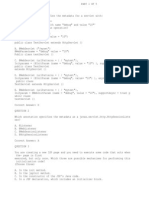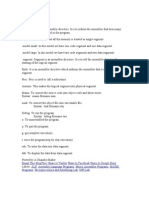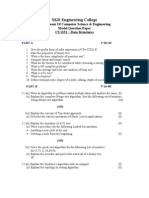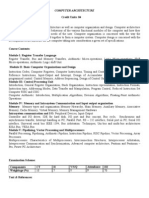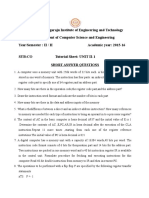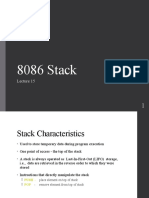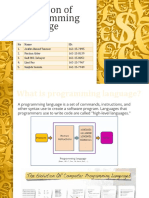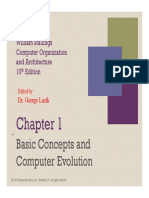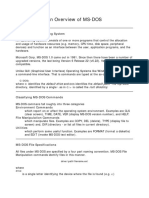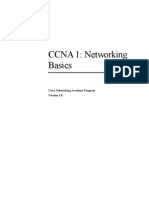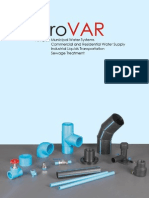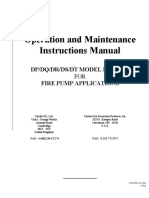Assembly Lab2
Assembly Lab2
Uploaded by
DaWheng VargasCopyright:
Available Formats
Assembly Lab2
Assembly Lab2
Uploaded by
DaWheng VargasCopyright
Available Formats
Share this document
Did you find this document useful?
Is this content inappropriate?
Copyright:
Available Formats
Assembly Lab2
Assembly Lab2
Uploaded by
DaWheng VargasCopyright:
Available Formats
Islamic University Gaza
Engineering Faculty
Department of Computer Engineering
ECOM 2125: Assembly Language LAB
Lab # 2
Introduction to Assembly
Language Programming
February, 2014
Assembly Language LAB
Intel IA-32 Processor Architecture
Intel introduced the 8086 processor in 1979. It has a 20-bit address bus and a 16-bit data bus.
The maximum physical memory that this processor can access is 220 bytes or 1MB. This
processor uses segmentation to address memory. The maximum size of a segment is restricted
to 216 bytes or 64 KB, since all registers were 16 bits at that time. With the advent of 32-bit
processors, starting with the 80386 in 1985, and continuing up with the latest Pentium family of
processors, Intel has introduced a 32-bit architecture known as IA-32. This family of processors
allows the use of 32-bit addresses that can address up to 4 Gigabytes of memory. These 32-bit
processors remove the limitations of the earlier 16-bit 8086 processor.
Basic Program Execution Registers
There are eight 32-bit general-purpose registers (EAX, EBX, ECX, EDX, ESI, EDI, EBP and ESP), a
32-bit register that holds the processor flags (EFLAGS), and a 32-bit instruction pointer (EIP).
These registers are shown below.
The general-purpose registers are primarily used for arithmetic and data movement. Each
register can be addressed as either a single 32-bit value or a 16-bit value. Some 16-bit registers
(AX, BX, CX, and DX) can be also addressed as two separate 8-bit values. For example, AX can be
addressed as AH and AL, as shown below.
Assembly Language LAB
Some general-purpose registers have specialized uses:
EAX is called the extended accumulator and is used by multiplication and division instructions.
ECX is the extended counter register and is used as a loop counter.
ESP is the extended stack pointer and is used to point to the top of the stack.
EBP is the extended base pointer and is used to access function parameters and local variables
on the stack.
ESI is called the extended source index and EDI is called the extended destination index. They
are used by string instructions.
EIP register is called the extended instruction pointer and contains the address of the next
instruction to be executed.
EFLAGS is the extended flags register that consists of individual bits that either control the
operation of the CPU or reflect the outcome of some CPU operations.
FLAT Memory Model
The FLAT memory model is used in 32-bit operating systems (like Windows XP) running on a 32bit processor. Each program addresses up to 4GB of memory. All code and data go into a single
32-bit (4-GigaByte) address space. Linear 32-bit addresses are used in each program to access
the program instructions and data in memory.
FLAT Memory Model Program Template
We will use the following template for writing FLAT memory programs. This template consists
of three types of statements: executable instructions, assembler directives, and macros.
Executable instructions generate machine code for the processor to execute at runtime.
Assembler directives provide information to the assembler while translating the program.
Macros are shorthand for a sequence of instructions, directives, or even other macros.
Assembly Language LAB
TITLE FLAT Memory Program Template (template.asm)
; Program Description:
; Author:
; Date Created:
; Last Modified:
.686
.MODEL FLAT, STDCALL
.STACK
INCLUDE Irvine32.inc
; (insert symbol definitions here)
.DATA
; (insert variables here)
.CODE
main PROC
; (insert executable instructions here)
exit ; exit to operating system
main ENDP
; (insert additional procedures here)
END main
TITLE FLAT Memory Program Template (template.asm)
This line is optional. The TITLE directive marks the entire line as a comment. It contains a brief
heading of the program and the file name.
; Program Description:
; Author:
; Date Created:
; Last Modified:
The next few lines are line comments. They begin with a semicolon (;) and terminate with the
end of the line. They are ignored and not processed by the assembler. However, they are used
to document a program and are of prime importance to the assembly language programmer,
because assembly language code is not easy to read or understand. Insert comments at the
beginning of a program to describe the program, its author, the date when it was first written
and the date when it was last modified. You need also comments to document your data and
your code.
.686
.MODEL FLAT, STDCALL
The .MODEL is a directive that specifies the memory configuration for the assembly language
program. For our purposes, the FLAT memory model will be used. The .686 is a processor
directive used before the .MODEL FLAT directive to provide access to the 32-bit instructions
and registers available in the Pentium Processor. The STDCALL directive tells the assembler to
use standard conventions for names and procedure calls.
The .STACK is a directive that tells the assembler to define a stack for the program. The size of
the stack can be optionally specified by this directive. The stack is required for procedure calls.
Assembly Language LAB
The .DATA is a directive that defines an area in memory for the program data. The program's
variables should be defined under this directive. The assembler will allocate storage for these
variables and initialize their locations in memory.
The .CODE is a directive defines the code section of a program. The code is a sequence of
assembly language instructions. These instructions are translated by the assembler into
machine code and placed in the code area in memory.
INCLUDE Irvine32.inc
The INCLUDE directive causes the assembler to include code from another file. We will include
Irvine32.inc that specifies basic input and output procedures provided by the book author Kip
Irvine, and that can be used to simplify programming. These procedures are defined in the
Irvine32.lib library that we will link to the programs that we will write.
main PROC
main ENDP
Under the code segment, we can define any number of procedures. As a convention, we will
define the first procedure to be the main procedure. This procedure is defined using the PROC
and ENDP directives.
exit
The exit at the end of the main procedure is used to terminate the execution of the program
and exit to the operating system. Note that exit is a macro. It is defined in Irvine32.inc and
provides a simple way to terminate a program.
END main
The END is a directive that marks the last line of the program. It also identifies the name (main)
of the programs startup procedure, where program execution begins.
Writing a Program using the FLAT Memory Model
The following program adds and subtracts integers. You may open it using any text editor.
TITLE Add and Subtract (addsub.asm)
; This program adds and subtracts integers
.686
.MODEL flat, stdcall
.STACK
INCLUDE Irvine32.inc
.code
main PROC
mov eax, 60000h ; EAX = 60000h
add eax, 80000h ; EAX = EAX + 80000h
sub eax, 20000h ; EAX = EAX - 20000h
Assembly Language LAB
exit
main ENDP
END main
Instructions
The above program uses 3 instructions.
The mov instruction is used for moving data.
The add instruction is used for adding two value.
The sub instruction is used for subtraction.
An instruction is a statement executed by the processor at runtime after the program has been
loaded into memory and started. An instruction contains four basic parts:
[label:] mnemonic [operands] [;comment]
A label is an identifier that acts as a place marker for an instruction. It must end with a colon (:)
character. The assembler assigns an address to each instruction. A label placed just before an
instruction implies the instruction address. Labels are often used as targets of jump
instructions.
An instruction mnemonic is a short word that identifies the operation carried out by the
instruction when it is executed at runtime. Instruction mnemonics have useful names, such as
mov, add, sub, jmp (jumping to a target instruction), and call (calling a procedure).
An instruction can have between zero and three operands, each of which can be a register,
memory operand, constant expression, or an I/O port. In the above program (addsub.asm), the
mov, add, and sub instructions used two operands. The first operand specified the destination,
which was the eax register. The second operand was a constant integer value.
An instruction can be terminated with an optional comment. The comment starts with a
semicolon (;) and terminates with the end of line. A comment at the end of an instruction can
be used as a short description and clarification for the use of that instruction.
Lab Work: Guessing the Value of the EAX Register
The constant values 60000h, 80000h, and 20000h are in hexadecimal. Guess and write the
values of the EAX register in the above program after the add and sub (subtract) instructions:
Value of EAX in hexadecimal after add =
Value of EAX in hexadecimal after sub =
Assembly Language LAB
Understanding Program Termination
The exit at the end of the main procedure is a macro. It is expanded into a system call to the
ExitProcess MS-Windows function that terminates the program. This function is defined in the
kernel32 library. To have a better understanding of program termination, remove the exit at
the end of the main procedure and replace it with the following two instructions:
exit push 0
call ExitProcess
The push 0 pushes the number 0 on the stack and the call instruction is used to call the function
ExitProcess. You can also replace exit with INVOKE ExitProcess, 0. The assembler will translate
into: push 0 and call ExitProcess as shown above.
There is no need to include the Irvine32.inc file, since the exit macro is no longer used.
However, there is a need to declare that ExitProcess is an external function defined outside the
addsub.asm program. We use the PROTO directive for this purpose. Therefore, remove the
INCLUDE directive and replace it with the PROTO directive as shown below:
INCLUDE Irvine32.inc ExitProcess PROTO, ExitCode:DWORD
The PROTO directive declares functions used by a program and defined outside the program
file. This directive also specifies the parameters and types of a given function.
Notice that addsub.obj is linked to the kernel32.lib because the ExitProcess function is defined
in the kernel32 library.
Editing, Assembling, Linking, and Debugging Programs
The process of editing, assembling, linking, and debugging programs is shown below.
The editor is used to write new programs and to make changes to existing ones. We will use
ConTEXT as editor.
Once a program is written, it can be assembled using the ML.exe program.
The assembler translates the source assembly (.asm) file into an equivalent object (.obj) file in
machine language. As an option, the assembler can also produce a listing (.lst) file. This file
shows the work of the assembler and contains the assembly source code, offset addresses,
translated machine code, and a symbol table.
Then it linked using the LINK32.exe program. The linker combines one or more object (.obj)
files produced by the assembler with one or more link library (.lib) files to produce the
executable program (.exe) file. In addition, the linker can produce an optional (.map) file. A
map file contains information about the program being linked. It contains a list of segment
groups in the program, a list of public symbols, and the address of the program's entry point.
Alternatively, it can be assembled and linked using the make32.bat program.
Once the executable program is generated, it can be executed and/or debugged.
A debugger allows you to trace the execution of a program and examine and/or modify the
content of registers and memory. With a debugger, you will be able to discover your errors in
the program. Once these errors are discovered, you will make the necessary changes in the
source assembly program. You will go back to the editor to make these changes, assemble, link,
and debug the program again. This cycle repeats until the program starts functioning properly,
and correct results are produced.
Assembly Language LAB
Lab Work: Assemble and link addsub.asm program
Open addsub.asm program using ConTEXT.
Assembly Language LAB
Press F9 to assemble and link it, or press
Run the Windows Debugger by pressing F10 or pressing
Open the source file addsub.asm from the File menu if it is not already opened. Watch the
registers by selecting Registers in the View menu or by pressing Alt+4. You can make the
Registers window floating or you can dock it as shown above.
Place the cursor at the beginning of the main procedure and press F7 to start the execution of
the main procedure as shown above. Press F10 to step through the execution of the main
procedure. Observe the changes to the EAX register after executing each instruction.
Assembly Language LAB
Homework Exercises
1. Using the addsub program as a reference, write a program that moves four integers into
the EAX, EBX, ECX, and EDX registers and then accumulates their sum into the EAX
register. Trace the execution of the program and view the registers using the windows
debugger.
2. Rewrite the above program using the 16-bit registers: AX, BX, CX, and DX.
Best Wishes
You might also like
- Smart City SrsDocument23 pagesSmart City Srssonufarkya99971% (7)
- Lab Manual Computer Organization & Assembly LanguageDocument89 pagesLab Manual Computer Organization & Assembly LanguageMuhammad AhmedNo ratings yet
- Thrust Block SizingDocument1 pageThrust Block Sizingn_zeinoun100% (1)
- JSF++ AV Coding Standard NLDocument36 pagesJSF++ AV Coding Standard NLWen-Yu ChenNo ratings yet
- DumpsDocument24 pagesDumpsGinny Ashish KukrejaNo ratings yet
- Modern Arm Assembly Language Programming: Covers Armv8-A 32-bit, 64-bit, and SIMDFrom EverandModern Arm Assembly Language Programming: Covers Armv8-A 32-bit, 64-bit, and SIMDNo ratings yet
- CSE-232 LAB ManualDocument23 pagesCSE-232 LAB ManualMuhammad Usman0% (1)
- Introduction To MASMDocument24 pagesIntroduction To MASMGnanasambanthan RajendranNo ratings yet
- Data Types in CDocument3 pagesData Types in Cayan shaikhNo ratings yet
- The Fetch and Execute Cycle: Machine Language: Next SectionDocument36 pagesThe Fetch and Execute Cycle: Machine Language: Next SectionSurageNo ratings yet
- Programming LanguageDocument1 pageProgramming Languagekj201992No ratings yet
- C++ Tutorial - Multi-Threaded Programming - C++ Class Thread For Pthreads - 2012Document15 pagesC++ Tutorial - Multi-Threaded Programming - C++ Class Thread For Pthreads - 2012David VianaNo ratings yet
- SKR Engineering College: Department of Computer Science & Engineering Model Question Paper CS 1151 - Data StructuresDocument4 pagesSKR Engineering College: Department of Computer Science & Engineering Model Question Paper CS 1151 - Data StructuresctvenkatNo ratings yet
- COA - Chapter # 9Document74 pagesCOA - Chapter # 9Set EmpNo ratings yet
- CSC3201 - Compiler Construction (Part II) - Lecture 5 - Code GenerationDocument64 pagesCSC3201 - Compiler Construction (Part II) - Lecture 5 - Code GenerationAhmad AbbaNo ratings yet
- x64 CheatsheetDocument9 pagesx64 CheatsheetahervalejoNo ratings yet
- Star Thermal Printer Programmer's ManualDocument117 pagesStar Thermal Printer Programmer's ManualKerzhanNo ratings yet
- Wireless Sensor Networks: Security, Attacks and ChallengesDocument13 pagesWireless Sensor Networks: Security, Attacks and ChallengesPradip KumarNo ratings yet
- Lab Manual Part-2, Assembly Language ProgrammingDocument15 pagesLab Manual Part-2, Assembly Language ProgrammingSyed Shiyaz Mirza86% (7)
- Group 6 Cpu Design PresentationDocument50 pagesGroup 6 Cpu Design PresentationFerry AriNo ratings yet
- C Faq ProgrammingDocument138 pagesC Faq ProgrammingTanmay MishraNo ratings yet
- C Programming NotesDocument96 pagesC Programming NotesNgatia MukereNo ratings yet
- Purpose of Language ProcessorsDocument7 pagesPurpose of Language Processorsall4downloads100% (2)
- 2629acomputer ArchitectureDocument15 pages2629acomputer ArchitectureSiddhant Jain SethNo ratings yet
- Introduction To Compiler DesignDocument15 pagesIntroduction To Compiler DesignSabalThapaliya100% (1)
- Computer Peripherals & InterfacingDocument128 pagesComputer Peripherals & InterfacingMd MianNo ratings yet
- Lecture-1 ARM Cortex M4-Based System PDFDocument36 pagesLecture-1 ARM Cortex M4-Based System PDFAnandNo ratings yet
- Computer OrganizationDocument77 pagesComputer OrganizationNagesh NadigatlaNo ratings yet
- 03 PIC16F84A Assembly ProgrammingDocument29 pages03 PIC16F84A Assembly ProgrammingMarcos Marcelon Alcantara Abueva IIINo ratings yet
- 2.0 - Pointers and ArraysDocument13 pages2.0 - Pointers and ArrayssangeethaNo ratings yet
- Bitwise OperatorsDocument4 pagesBitwise OperatorsslspaNo ratings yet
- Bitwise Operators in C and C++Document6 pagesBitwise Operators in C and C++Appu Durai100% (1)
- 6502 Addressing ModesDocument3 pages6502 Addressing ModescalixrvNo ratings yet
- Senior Software Firmware Engineer in Sacramento CA Resume Keith WalbergDocument2 pagesSenior Software Firmware Engineer in Sacramento CA Resume Keith WalbergKeithWalbergNo ratings yet
- Compiler DesignDocument47 pagesCompiler DesignLearn UpNo ratings yet
- CO Unit 2-1Document15 pagesCO Unit 2-1Aravinder Reddy SuramNo ratings yet
- Today's Topic:: To Run A Single Program Is Easy What To Do When Several Programs Run in Parallel?Document33 pagesToday's Topic:: To Run A Single Program Is Easy What To Do When Several Programs Run in Parallel?saireddy4b1100% (2)
- CS114 - Fundamentals of Programming: Qurrat-Ul-Ain BabarDocument80 pagesCS114 - Fundamentals of Programming: Qurrat-Ul-Ain BabarAwais Bashir Kalyar100% (1)
- Qbasic NotesDocument7 pagesQbasic Notesjecom79703No ratings yet
- Porting GuideDocument4 pagesPorting Guideboot_sectorzNo ratings yet
- Lecture 15 8086 StackDocument37 pagesLecture 15 8086 Stackfreddy tanatsaNo ratings yet
- Introduction To C ProgrammingDocument81 pagesIntroduction To C ProgrammingAshish Kadam100% (1)
- Unit II - Loops and Function Pointers, QueuesDocument34 pagesUnit II - Loops and Function Pointers, QueuesDatta RajendraNo ratings yet
- Kochar Inderkumar Asst. Professor MPSTME, MumbaiDocument66 pagesKochar Inderkumar Asst. Professor MPSTME, MumbaiKochar InderkumarNo ratings yet
- Robotics in ChemistryDocument19 pagesRobotics in ChemistryZoni MansoorNo ratings yet
- C Programming NotesDocument62 pagesC Programming NotestheantarikshaNo ratings yet
- Good Questions To Ask AssemblyDocument12 pagesGood Questions To Ask AssemblyAbdul Qadeer Khan100% (1)
- Principles of Compiler Design - Tutorial 9Document7 pagesPrinciples of Compiler Design - Tutorial 9dani cabiloNo ratings yet
- C++ CallbackDocument29 pagesC++ Callbackragesh100% (1)
- C++ Data File Handling SolutionDocument20 pagesC++ Data File Handling SolutionSaransh MathurNo ratings yet
- Microcontroller and InterfacingDocument3 pagesMicrocontroller and InterfacingAdil Ayub100% (1)
- Intel Microprocessor History: Ramzi Shihadeh AlqrainyDocument48 pagesIntel Microprocessor History: Ramzi Shihadeh AlqrainyRamzi Alqrainy100% (2)
- Lpc1343 IntroductionDocument11 pagesLpc1343 Introductionshahbazalam4a5No ratings yet
- Lesson 7 of C ProgrammingDocument20 pagesLesson 7 of C ProgrammingRyle PlatinoNo ratings yet
- Computer Organization and Assembly Language: Week 1 To 3 Dr. Muhammad Nouman DurraniDocument68 pagesComputer Organization and Assembly Language: Week 1 To 3 Dr. Muhammad Nouman DurranipokaNo ratings yet
- Caal Lab ManualDocument63 pagesCaal Lab ManualFarrukh Abbasi100% (1)
- Evolution of Programming LanguageDocument18 pagesEvolution of Programming LanguageSadi ZobaerNo ratings yet
- CortexM4 FPUDocument14 pagesCortexM4 FPUMohamedAliFerjaniNo ratings yet
- 5unix BackgroundDocument10 pages5unix BackgroundDaWheng VargasNo ratings yet
- What Is An Operating System?Document9 pagesWhat Is An Operating System?DaWheng VargasNo ratings yet
- Windows 7: by Qais A. MarjiDocument88 pagesWindows 7: by Qais A. MarjiDaWheng VargasNo ratings yet
- Computer Skills: CIS-100 - 2013 Qais MarjiDocument45 pagesComputer Skills: CIS-100 - 2013 Qais MarjiDaWheng VargasNo ratings yet
- Welcome To Computer LaboratoryDocument10 pagesWelcome To Computer LaboratoryDaWheng VargasNo ratings yet
- Ch.05 Aassignment PowerPointDocument2 pagesCh.05 Aassignment PowerPointDaWheng VargasNo ratings yet
- 8io and RedirectionDocument12 pages8io and RedirectionDaWheng VargasNo ratings yet
- Lab03 BinaryArithmeticDocument4 pagesLab03 BinaryArithmeticDaWheng VargasNo ratings yet
- Scoping and Testing: Professor Jennifer Rexford COS 217Document34 pagesScoping and Testing: Professor Jennifer Rexford COS 217DaWheng VargasNo ratings yet
- Number Systems Quiz PDFDocument1 pageNumber Systems Quiz PDFDaWheng VargasNo ratings yet
- IBM TapeDocument11 pagesIBM TapeDaWheng VargasNo ratings yet
- Computer Organization and Architecture 8 EditionDocument15 pagesComputer Organization and Architecture 8 EditionDaWheng VargasNo ratings yet
- Basic Concepts and Computer EvolutionDocument56 pagesBasic Concepts and Computer EvolutionDaWheng VargasNo ratings yet
- Module 1: Overview of PlatformDocument16 pagesModule 1: Overview of PlatformDaWheng VargasNo ratings yet
- Ccna 4: Wan Technologies: Cisco Networking Academy ProgramDocument9 pagesCcna 4: Wan Technologies: Cisco Networking Academy ProgramEzzyOrwobaNo ratings yet
- Course 2373B: Programming With Microsoft Visual BasicDocument8 pagesCourse 2373B: Programming With Microsoft Visual BasicDaWheng VargasNo ratings yet
- An Overview of MS-DOSDocument4 pagesAn Overview of MS-DOSDaWheng VargasNo ratings yet
- Module 2: Development Environment FeaturesDocument32 pagesModule 2: Development Environment FeaturesDaWheng VargasNo ratings yet
- 2: Application Layer 1Document79 pages2: Application Layer 1DaWheng VargasNo ratings yet
- Ccna 1Document13 pagesCcna 1Amilcar Fernando Ferreira MartinsNo ratings yet
- OSI Data Link Layer: Network Fundamentals - Chapter 7Document21 pagesOSI Data Link Layer: Network Fundamentals - Chapter 7DaWheng VargasNo ratings yet
- ch1 PDFDocument57 pagesch1 PDFDaWheng VargasNo ratings yet
- Asarn 83Document38 pagesAsarn 83Emmet HearonNo ratings yet
- Cisco AnyConnect DeploymentDocument16 pagesCisco AnyConnect Deploymenteliud_buenoNo ratings yet
- Differences Between Gabion and MattressesDocument1 pageDifferences Between Gabion and MattressesGA JonNo ratings yet
- EscalatorsDocument29 pagesEscalatorsKasthala Samanth100% (1)
- PD 1096 NBCDocument56 pagesPD 1096 NBCAleli LunaNo ratings yet
- Oracle Hospitality RES 3700: Installation Guide Release 5.6Document39 pagesOracle Hospitality RES 3700: Installation Guide Release 5.6FisayoNo ratings yet
- Automatic Car Engine Locking System For Drunken DrivingDocument56 pagesAutomatic Car Engine Locking System For Drunken DrivingsujathaNo ratings yet
- S3-0-0 - Typical Slab On Grade Details PDFDocument1 pageS3-0-0 - Typical Slab On Grade Details PDFVictor Miranda AcuñaNo ratings yet
- Hydro Var HDPE CatalogueDocument32 pagesHydro Var HDPE Catalogueraigouki0% (1)
- Motherboard Manual 6vem eDocument67 pagesMotherboard Manual 6vem eAri Ercilio Farias FereirraNo ratings yet
- Jane Burry and Mark Burry The New Mathematics of ArchitectureDocument3 pagesJane Burry and Mark Burry The New Mathematics of Architectureccamiloo moraNo ratings yet
- S 000 5310 001 (Structual)Document33 pagesS 000 5310 001 (Structual)Midhun K ChandraboseNo ratings yet
- Roof PlanDocument1 pageRoof PlanMoulidy MarjebyNo ratings yet
- Diagnostic Test For CPARDocument6 pagesDiagnostic Test For CPARJUSTINE CID PAUL BALAURONo ratings yet
- Method of JointsDocument18 pagesMethod of Jointsfaraeiin57No ratings yet
- A31.1 Fourth Floor Furniture Wing-1Document1 pageA31.1 Fourth Floor Furniture Wing-1Azkagul 28No ratings yet
- Ds-Cma3000-Sdh-E3 - 01-09 SDHDocument10 pagesDs-Cma3000-Sdh-E3 - 01-09 SDHahmedelhajsaNo ratings yet
- DamsDocument9 pagesDamsRichard TagleNo ratings yet
- Valvulas de Guillotina: FlachschieberDocument14 pagesValvulas de Guillotina: FlachschieberRicardo Diaz AristaNo ratings yet
- En 12101 344 Powered Smoke Exhaust SystemsDocument6 pagesEn 12101 344 Powered Smoke Exhaust SystemspsmanasseNo ratings yet
- Sample Final UccsDocument17 pagesSample Final UccsMohamedNo ratings yet
- Cloud ComputingDocument16 pagesCloud ComputingKranthi kumarNo ratings yet
- Module 0 Construction Veniacular TermsDocument30 pagesModule 0 Construction Veniacular Termszedrickjay.navarroNo ratings yet
- Ma Unigear (En) F 1vlm000363Document106 pagesMa Unigear (En) F 1vlm000363Oliver NaraNo ratings yet
- FlooringDocument89 pagesFlooringMohsin Khizer RajpootNo ratings yet
- Diesel Engine Operation ManualDocument50 pagesDiesel Engine Operation Manualtungskha100% (2)
- Emissary v2.0.0 User Manual PDFDocument12 pagesEmissary v2.0.0 User Manual PDFCaloy CabreraNo ratings yet




